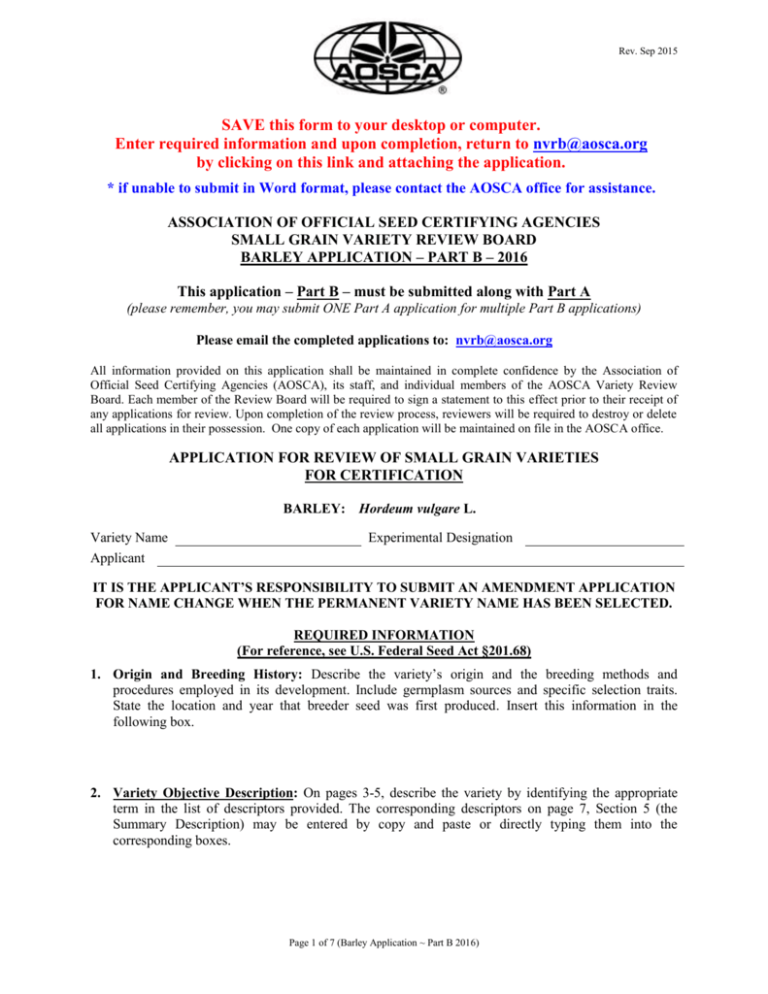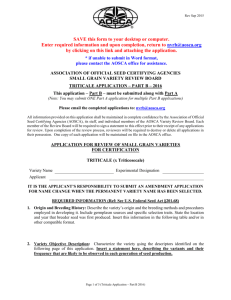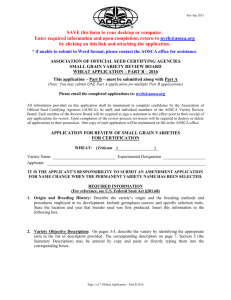2016 Small Grains Application - Part B - Barley
advertisement

Rev. Sep 2015 SAVE this form to your desktop or computer. Enter required information and upon completion, return to nvrb@aosca.org by clicking on this link and attaching the application. * if unable to submit in Word format, please contact the AOSCA office for assistance. ASSOCIATION OF OFFICIAL SEED CERTIFYING AGENCIES SMALL GRAIN VARIETY REVIEW BOARD BARLEY APPLICATION – PART B – 2016 This application – Part B – must be submitted along with Part A (please remember, you may submit ONE Part A application for multiple Part B applications) Please email the completed applications to: nvrb@aosca.org All information provided on this application shall be maintained in complete confidence by the Association of Official Seed Certifying Agencies (AOSCA), its staff, and individual members of the AOSCA Variety Review Board. Each member of the Review Board will be required to sign a statement to this effect prior to their receipt of any applications for review. Upon completion of the review process, reviewers will be required to destroy or delete all applications in their possession. One copy of each application will be maintained on file in the AOSCA office. APPLICATION FOR REVIEW OF SMALL GRAIN VARIETIES FOR CERTIFICATION BARLEY: Hordeum vulgare L. Variety Name Applicant Experimental Designation IT IS THE APPLICANT’S RESPONSIBILITY TO SUBMIT AN AMENDMENT APPLICATION FOR NAME CHANGE WHEN THE PERMANENT VARIETY NAME HAS BEEN SELECTED. REQUIRED INFORMATION (For reference, see U.S. Federal Seed Act §201.68) 1. Origin and Breeding History: Describe the variety’s origin and the breeding methods and procedures employed in its development. Include germplasm sources and specific selection traits. State the location and year that breeder seed was first produced. Insert this information in the following box. 2. Variety Objective Description: On pages 3-5, describe the variety by identifying the appropriate term in the list of descriptors provided. The corresponding descriptors on page 7, Section 5 (the Summary Description) may be entered by copy and paste or directly typing them into the corresponding boxes. Page 1 of 7 (Barley Application ~ Part B 2016) Rev. Sep 2015 3. Supporting Information: Provide data to characterize the variety in the following areas: a) Yield and other agronomic responses obtained from test locations that support the area of adaptation. b) Disease and insect resistance reactions and the testing conditions used to determine them (i.e., field, greenhouse, or laboratory). State specific races or strains of organisms, if known. c) Provide evidence of quality and/or other relevant attributes if these claims are used as a means of identifying the variety. Provide separate data from at least two years and two locations in the area of adaptation for agronomic traits, as appropriate. Include and identify at least one recognized check variety for yield and quality traits, if applicable. Include and identify susceptible and resistant checks for comparative pest reactions. Present all data in well-constructed tables appended to the end of this application. Number the tables and indicate where the data were collected. Include captions or footnotes as necessary to clearly explain the nature of the units of measurements used in the header. Provide the number of entries in the tests, the test grand mean, and a measure of statistical significance for each location-year or test. 4. Summary Description: Provide a concise single-page description of the variety for AOSCA to publish for use by official seed certifying agencies. All claims must be supported by data. Use the instructions and template located at the end of this application. Page 2 of 7 (Barley Application ~ Part B 2016) Rev. Sep 2015 VARIETY OBJECTIVE DESCRIPTION BARLEY (Hordeum vulgare L.) Variety Name: Instructions: Select one (1) descriptor (except where otherwise instructed) by entering ‘X’ in the appropriate field. 1. GROWTH HABIT: Winter Spring Other 2. SPIKE: Two-row Six-row 3. COLEOPTILE COLOR: Green Purple Other 4. JUVENILE GROWTH HABIT: Prostate Semi-erect or Semi-prostrate Erect 5. PLANT TILLERING: Low Intermediate High 6. LEAF COLOR AT BOOT: Yellow-Green Green Dark Green Blue-Green 7. FLAG LEAF AT BOOT: Erect Recurved Twisted Not-Twisted Waxy Bloom No Waxy Bloom 8. PUBESCENCE ON LEAF BLADE: Yes No 9. PUBESCENCE ON LEAF SHEATH: Yes No 10. AURICLE COLOR: White Purple Other 11. HEADING DATE / ANTHESIS: (select one) Averages than Day(s) Earlier Later (select one, using X) (known variety) Page 3 of 7 (Barley Application ~ Part B 2016) Rev. Sep 2015 12. STEM COLOR: White Purple Other 13. NECK SHAPE: Straight Snaky Other 14. COLLAR SHAPE: V-Shaped Open 15. SPIKE EXSERTION: Slight Intermediate Full 16. PLANT HEIGHT: (select one) Average number in centimeters: (insert height in Item 5.16 of Summary Description, page 7) This averages cm TALLER cm SHORTER than (select one, using X) (known variety) SPIKE CHARACTERISTICS 17. SHAPE: Fusiform Oblong Clavate Other 18. DENSITY: Lax Mid-Dense Dense 19. POSITION AT MATURITY: Erect Inclined Nodding 20. HAIRINESS OF RACHIS EDGE: Lacking Few Covered 21. RACHILLA HAIR LENGTH: Short Long LEMMA CHARACTERISTICS 22. AWNS: Awnless Elevated Hoods Sessile Hoods 23. AWN LENGTH: Short Equal To Spike Long 24. AWN SURFACE: Smooth Semi-smooth Rough Page 4 of 7 (Barley Application ~ Part B 2016) Straight Rev. Sep 2015 GLUME CHARACTERISTICS 25. HAIRINESS: None Middle Only Banded Covered 26. AWN SURFACE: Smooth Semi-smooth Rough KERNEL CHARACTERISTICS 27. GLUME/LEMMA ADHERENCE: Covered Naked 28. TEXTURE, IF COVERED: Wrinkled Semi-Wrinkled Slightly Wrinkled 29. ALUERONE COLOR: Colorless Blue 30. AVG. 1,000-KERNEL WEIGHT : Lighter than than Same as gm which is: Heavier (select one) (known variety) 31. List or state any other traits or special markers that may be helpful in identifying the variety, including characteristics determined using biochemical methods (e.g. phenol reaction or electrophoresis): Page 5 of 7 (Barley Application ~ Part B 2016) Rev. Sep 2015 Summary Description: Provide a concise, single page description of the variety on the next page for AOSCA to publish for use by official seed certifying agencies. All claims must be supported by data. You must use the categories described below, using COMPLETE SENTENCES. Insert your text in the blank cell next to the item number. PLEASE DELETE THIS INSTRUCTION PAGE WHEN SUBMITTING AN APPLICATION. 1. The name of the variety, including its experimental designation, its market class and the identity of the developer and/or owner. Example: Nubarley (Experimental no.) is a six-row spring feed barley developed and marketed by ABC Breeding Company. 2. A summary statement of the selection criteria and breeding procedures previously described. Confidential business information is not required. Example: Nubarleywas selected for high spike density, lodging resistance, and resistance to Xanthomonas using the single seed descent method. 3. Area of probable adaptation, testing locations and primary purpose for which the variety will be used. Example: Nubarley was tested in the Central Valley of California and is well-adapted as feed barley in the irrigated production areas of the Central Valley and similar areas of the southwestern states. 4. A statement relative to the variety’s disease and insect resistance. Example: Nubarley is moderately resistant to leaf rust and barley yellow dwarf virus. 5. Provide a detailed description of morphological, physiological and other identifying characteristics by transferring information from the Variety Objective Description into the table on the next page. Include a description of variants and their frequency. 6. State the certified seed classes to be recognized, party responsible, and procedure adopted for maintaining seed stocks, with limitations, if any. State whether the variety is subject to collection of a royalty fee by certifying agencies and whether any kind of stewardship or licensing agreement is required that would affect certifying agency activities.. Example: Recognized classes of Nubarley are breeder, foundation, registered, and certified. ABC Breeding Company will maintain the variety by the head-row method to produce breeder seed as needed and will produce all foundation seed. No royalty fees or licensing agreements are anticipated. 7. State the likely date that certified seed will first be offered for sale. Example: Certified class seed will likely be available for the 2013 growing season, if accepted as eligible. 8. State whether or not application will be submitted for protection under the U.S. Plant Variety Protection Act and, if appropriate, whether or not the “Certification Option” will be elected (to be sold by variety name only as a class of certified seed). If application for PVP is not planned, state whether relevant descriptive data (morphological only) can be supplied to the PVP database. Examples: Application for PVP is anticipated with the option that Nubarley can be sold by variety name only as a class of certified seed. OR: Application for PVP is not planned and descriptive data may be supplied to the PVP database. 9. State whether or not certified seed production acreage can be published by AOSCA and certifying agencies. Examples: Certified seed production acreage (may) (is not to) be published by AOSCA and certifying agencies. Page 6 of 7 (Barley Application ~ Part B 2016) Rev. Sep 2015 Barley Insert Variety Name Here Insert Experimental Designation Name(s) Here 1. 2. 3. 4 5. Identifying characteristics – insert the descriptive term from the Objective Description (pages 3-5) except where indicated: 1. Growth Habit: 2. Spike: 3. Coleoptile Color: 4. Juvenile Growth Habit: 5. Plant Tillering: 6. Leaf Color at Boot: 7. Flag Leaf at Boot: 8. Pubescence on Leaf Blade: 9. Pubescence on Leaf Sheath: 10.:Auricle Color: 11.Heading Date (see below): 12. Stem Color: 13. Neck Shape: 14. Collar Shape: 15. Spike Exsertion: Heading date: Plant height: which is: cm, which is 16. Plant Height (see below): 17. Spike Shape: 18. Spike Density: 19. Spike Position at Maturity: 20. Hairiness of Rachis Edge: 21. Rachilla Hair Length: 22. Lemma Awns: 23. Length of Lemma Awns: 24. Lemma Awn Surface: 25. Glume Hairiness: 26. Glume Awn Surface: 27. Glume/Lemma Adherence: 28. Texture (if covered): 29. Aleurone Color: 30. Avg 1,000 Kernel Wt (g): Day(s) (EARLIER) (LATER) than: cm (SHORTER) (TALLER) (SAME AS) Physiological or biochemical traits: Variants and their frequency: 6. 7. 8. 9. Page 7 of 7 (Barley Application ~ Part B 2016)







